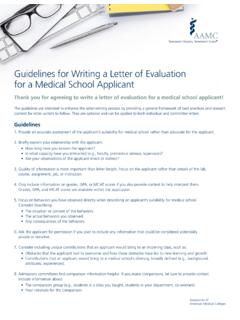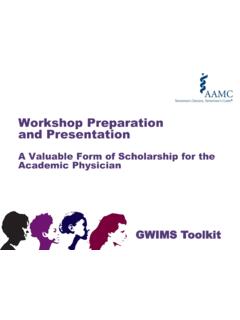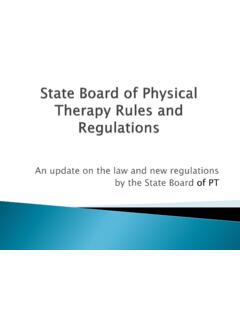Transcription of The Road to Becoming a Doctor - Association of American ...
1 Association of American Medical CollegesThe Road to Becoming a Doctor Association ofAmerican Medical CollegesPhysician training lasts between seven and 15 years. How and what future physicians learn is constantly updated to align with the latest medical knowledge, groundbreaking research, emerging and ongoing public health threats, and community needs. America s medical schools and teaching hospitals provide environments for innovative learning to ensure tomorrow s doctors are ready to practice in an ever-changing health care system. This document outlines the journey of Becoming a physician and provides information on the federal programs that play a role along that 2020 Before Medical School Students interested in Becoming physicians take rigorous prerequisite courses and the Medical College Admission Test ( MCAT ).
2 Many medical school admissions officers use a holistic review process when considering applications, balancing applicants experiences, attributes, and academics to gauge how they might contribute as medical students and physicians to caring for patients and improving the health of all. Federal Role Efforts to engage young people in the health professions supported by the Health Resources and Services Administration Title VII programs , such as the Health Careers Opportunity Program, and other efforts help recruit students from underrepresented backgrounds. They also provide mentorship and support for enrolled health professions students. Medical School Four Year s* Coursework through classroom, clinical, and community experiences covers science, the latest innovations in treatment and diagnosis, problem-solving and communication skills, prevention and care, professionalism, and medical ethics.
3 Medical students are trained in these areas alongside other future health professionals. Each medical school develops its own curriculum, in part, to meet the health care needs of its community, the unique mission of the school, and the learning needs of its students while also meeting the Liaison Committee on Medical Education s rigorous requirements for accreditation. All institutions integrate research into the curriculum. For students interested in combining medical school and graduate school within an integrated curriculum, 114 institutions offer joint MD-PhD programs . Federal Role Title VII Area Health Education Centers and partnerships with other institutions allow students to train in a variety of settings, including community health centers and physicians offices.
4 Other Title VII programs in primary care, geriatrics, and behavioral health support enhanced training in certain areas for medical students and other health professions students. * Although innovative programs that may decrease the number of years in medical school are being offered and tested, the vast majority of medical school programs are four Match During the final year of medical school, students choose the type of medicine they will practice on the basis of personal interests, clinical experiences, and other factors and apply to residency programs . There are more than 120 options to choose from, including family medicine, pediatrics, emergency medicine, geriatrics, oncology, psychiatry, and surgical specialties like neurosurgery and ophthalmology. At the same time, students often develop specialty-specific skills and explore other areas important to medicine, including research, public health, and global health.
5 Most students are matched to one of their preferred residency programs through the National Resident Matching Program (NRMP ). On Match Day in March, students learn where they will begin their residency training. residency Training Three to Seven Years During graduate medical education (GME), resident physicians receive supervised, hands-on training in programs accredited by the Accreditation Council on Graduate Medical Education. Residents train as part of a patient care team alongside other health practitioners and under the supervision of attending physicians. Exposure to specialized services, a variety of care settings (including community clinics, rural settings, and Veterans Affairs facilities), diverse patients and cases, and cutting-edge research and care prepares them to treat all patients no matter where they choose to practice.
6 Some residents choose to undertake a fellowship after completing their residencies, adding one to three years of study in a subspecialty Role The costs directly associated with this training are covered in part by Medicare Direct Graduate Medical Education (DGME) payments, although these payments have been limited since 1997. Teaching hospitals cover the full costs of training more than 18,000 residents above those supported by DGME Medical Education A physician must obtain a state license to practice medicine. After completing residency , many physicians also become board certified in their chosen specialty. Twenty-four specialty boards establish criteria physicians must meet to be certified. The rapid pace of change in medicine makes continuing medical education programs or continuing professional development essential.
7 Specialty boards require regular recertification, a process called continuing Role Public Service Loan Forgiveness (PSLF), the National Health Service Corps (NHSC), and other federal programs help physicians repay any loans accrued in medical school in exchange for practicing in underserved and rural (11/20)About the AAMCThe AAMC ( Association of American Medical Colleges) is a not-for-profit Association dedicated to transforming health through medical education, health care, medical research, and community collaborations. Its members are all 155 accredited and 17 accredited Canadian medical schools; more than 400 teaching hospitals and health systems, including Department of Veterans Affairs medical centers; and more than 70 academic societies. Through these institutions and organizations, the AAMC leads and serves America s medical schools and teaching hospitals and their more than 179,000 full-time faculty members, 92,000 medical students, 140,000 resident physicians, and 60,000 graduate students and postdoctoral researchers in the biomedical sciences.
8 Additional information about the AAMC is available at











